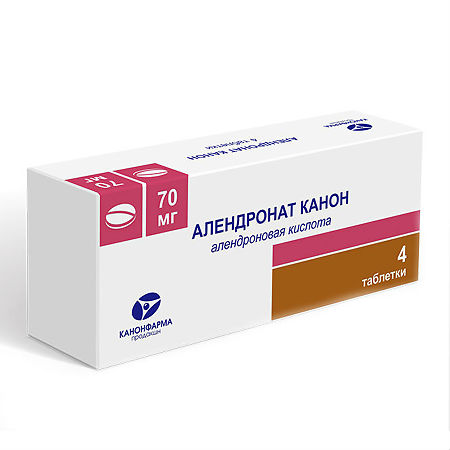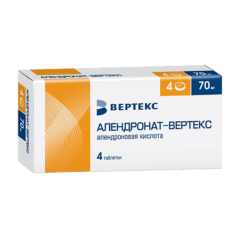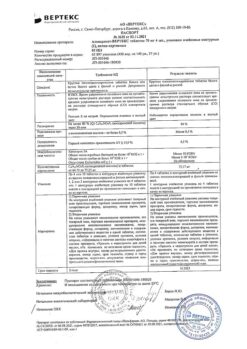No products in the cart.
Alendronate, tablets 70 mg 4 pcs
€1.00
Out of stock
(E-mail when Stock is available)
Description
The active ingredient in Alendronate Canon, alendronate sodium trihydrate, is a bisphosphonate (from the group of aminobisphosphonates – synthetic analogues of pyrophosphate binding hydroxyapatite present in bone) which inhibits osteoclast-mediated bone resorption without directly affecting new bone formation.
Alendronic acid predominantly localizes in areas of active bone resorption.
It inhibits osteoclast activity, but has no effect on osteoclast recruitment and attachment. During treatment with alendronic acid bone tissue with normal histological structure is formed.
Pharmacokinetics
Absorption
The bioavailability of alendronic acid when taken orally on an empty stomach in the morning two hours before a standard breakfast at a dose of 5-70 mg is 0.64% in women and 0.6% in men. When alendronic acid was taken on an empty stomach 0.5-1 hours before a standard breakfast, the bioavailability decreased to 0.46% and 0.39%, respectively.
The bioavailability of alendronic acid is significantly reduced if the drug is taken less than 30 minutes before meals or liquids, the bioavailability is minimal when taken with food or within two hours after meals.
If alendronic acid is taken concomitantly with coffee or orange juice, the bioavailability is reduced by approximately 60%.
Distribution
The average equilibrium volume of distribution, excluding bone, in humans is at least 28 liters. Plasma concentrations of alendronic acid after oral administration of a therapeutic dose are too low for analytical detection (< 5 ng/mL). Binding to plasma proteins in humans is approximately 78%.
Metabolism
There is no evidence that alendronic acid is metabolized in humans or animals.
Excretion
Excreted unchanged. Excretion is characterized by rapid reduction of alendronic acid concentration in blood plasma and extremely slow release from bones. When administered intravenously after 6 hours the plasma concentration decreases by more than 95%.
Alendronic acid absorbed but not embedded in bone tissue is rapidly excreted by the kidneys. After a single intravenous dose of [14C]alendronic acid, approximately 50% of the radioactivity was excreted in the urine within 72 hours and little or no excretion in the feces.
The renal clearance of alendronic acid was 71 mL/min, and systemic clearance did not exceed 200 mL/min. Plasma concentrations decreased by more than 95% within six hours after intravenous administration. The end-phase elimination half-life in humans has been estimated to exceed ten years, reflecting the skeletal release of alendronic acid.
Alendronic acid is not excreted through the acid and basic kidney transport systems in rats; thus, it would not be expected to impair the excretion of other drugs through these systems in humans.
Pharmacokinetics in Special Patient Groups
Position
The bioavailability of alendronic acid is not significantly different in men and women.
Race
Pharmacokinetic differences by race have not been studied.
Elderly patients
The bioavailability and excretion of alendronic acid are similar in elderly and younger patients.
Patients with impaired liver function
In patients with impaired liver function there is no need to adjust the dose of alendronic acid because it is not metabolized and excreted with the bile.
Hepatic impairment
Preclinical studies have shown that the drug, which does not accumulate in bone tissue, is rapidly excreted in the urine. No evidence of saturation accumulation in bone tissue was found after repeated administration of cumulative intravenous doses up to 35 mg/kg in animals.
While no clinical data are available, it is likely that, as in animals, excretion of alendronic acid through the kidneys will be reduced in patients with impaired renal function.
Hence, slightly greater accumulation of alendronic acid in bone tissue can be expected in patients with impaired renal function (see section “Dosage and administration”).
Indications
Indications
Treatment of osteoporosis in postmenopausal women to prevent the development of fractures, including hip fractures and vertebral compression fractures.
Treatment of osteoporosis in men to prevent fractures.
Pharmacological effect
Pharmacological effect
The active substance of the drug Alendronate Canon, alendronate sodium trihydrate, is a bisphosphonate (from the group of aminobisphosphonates – synthetic analogues of pyrophosphate that binds hydroxyapatite found in bone), which inhibits the process of bone resorption mediated by osteoclasts, without directly affecting the process of formation of new bone tissue.
Alendronic acid is predominantly localized in areas of active bone resorption.
It inhibits osteoclast activity but has no effect on osteoclast recruitment and attachment. During treatment with alendronic acid, bone tissue with a normal histological structure is formed.
Pharmacokinetics
Suction
The bioavailability of alendronic acid when taken orally on an empty stomach in the morning two hours before a standard breakfast at a dose of 5-70 mg is 0.64% in women and 0.6% in men. When alendronic acid was taken on an empty stomach 0.5-1 hour before a standard breakfast, bioavailability decreased to 0.46% and 0.39%, respectively.
The bioavailability of alendronic acid is significantly reduced if the drug is taken less than 30 minutes before a meal or liquid; bioavailability is minimal when taken with food or within two hours after a meal.
When alendronic acid is taken concomitantly with coffee or orange juice, bioavailability is reduced by approximately 60%.
Distribution
The average steady-state volume of distribution, excluding bones, in humans is at least 28 liters. Plasma concentrations of alendronic acid after oral administration of a therapeutic dose are too low for analytical detection (<5 ng/mL). Plasma protein binding in humans is approximately 78%.MetabolismThere is no evidence that alendronic acid is metabolized in humans or animals.RemovalOutput unchanged. The elimination process is characterized by a rapid decrease in the concentration of alendronic acid in the blood plasma and an extremely slow release from the bones. When administered intravenously, after 6 hours the plasma concentration decreases by more than 95%.
Alendronic acid that is absorbed but not incorporated into bone tissue is quickly excreted by the kidneys. After a single intravenous dose of [14C] alendronic acid, approximately 50% of the radioactivity was excreted in the urine within 72 hours and little or no radioactivity was excreted in the feces.
The renal clearance of alendronic acid was 71 ml/min, and the systemic clearance did not exceed 200 ml/min. Plasma concentrations decreased by more than 95% within six hours after intravenous administration. The terminal half-life in humans is estimated to be greater than ten years, reflecting the release of alendronic acid from the skeleton.
Alendronic acid is not excreted through the acid and base transport systems of the kidneys in rats; thus it can be expected that it does not interfere with the elimination of other drugs through these systems in humans.
Pharmacokinetics in special groups of patients
Floor
The bioavailability of alendronic acid does not differ significantly between men and women.
Race
Pharmacokinetic differences by race have not been studied.
Elderly patients
The bioavailability and excretion of alendronic acid are similar in elderly and young patients.
Patients with liver dysfunction
In patients with impaired liver function, there is no need to adjust the dose of alendronic acid, since it is not metabolized and is not excreted in the bile.
Kidney failure
Preclinical studies have shown that the drug, which does not accumulate in bone tissue, is rapidly excreted in the urine. There was no evidence of saturable accumulation in bone tissue after repeated administration of cumulative intravenous doses up to 35 mg/kg in animals.
Although no clinical data are available, it is likely that, as in animals, renal excretion of alendronic acid will be reduced in patients with impaired renal function.
Thus, in patients with impaired renal function, a slightly greater accumulation of alendronic acid in bone tissue can be expected (see section “Dosage and Administration”).
Special instructions
Special instructions
Alendronate should only be taken with plain water, since other drinks (including mineral water, coffee, tea, orange juice) reduce the absorption of alendronic acid.
Absorption of bisphosphonates is significantly reduced when administered concomitantly with food.
To reduce the irritating effect on the esophagus, Alendronate should be taken immediately after getting up in the morning with a full glass of water.
After administration, you should be in an upright position (standing or sitting) for 30 minutes (it is dangerous to use the drug if the patient is unable to stand or sit straight for the specified time). Taking Alendronate before bed or in a horizontal position increases the risk of developing esophagitis.
The patient should be informed of the need to stop taking Alendronate and consult a doctor if dysphagia develops, pain when swallowing, chest pain or heartburn occurs.
In case of hypocalcemia, it is necessary to correct it before starting treatment.
It is also necessary to eliminate mineral metabolism disorders that lead to hypocalcemia (vitamin D deficiency, hypoparathyroidism, calcium malabsorption). Therapy should be carried out against the background of a diet enriched with calcium salts.
When taking bisphosphonates (especially with concomitant therapy with glucocorticosteroid drugs), it is necessary to ensure the intake of adequate amounts of calcium and vitamin D from food or in the form of medications.
During treatment, due to the positive effect of alendronic acid on bone mineral density, a slight asymptomatic decrease in the concentration of calcium and phosphate in the blood serum may be observed.
Before prescribing bisphosphonate therapy, patients with underlying risk factors (eg, cancer, chemotherapy, radiation therapy, corticosteroids, poor oral hygiene) should undergo a dental examination with appropriate preventative dental treatment.
Patients being treated with bisphosphonates should avoid invasive dental procedures whenever possible. Osteonecrosis of the jaw, usually associated with tooth extraction and/or local infection (including osteomyelitis), has been reported in cancer patients receiving intravenous bisphosphonates (many of whom were also prescribed chemotherapy and corticosteroids).
There are reports of the development of osteonecrosis of the jaw in patients with osteoporosis during the use of oral bisphosonates.
In patients with osteonecrosis of the jaw who are on bisphosphonate therapy, dental surgery may worsen the condition.
If surgical interventions are necessary, it should be taken into account that there is no data on the possibility of reducing the risk of developing osteonecrosis of the jaw after discontinuation of a bisphosphonate. Prescriptions and recommendations of the attending physician should be based on an individual assessment of the benefit/risk ratio for each patient.
Active ingredient
Active ingredient
Alendronic acid
Composition
Composition
Alendronate sodium trihydrate 91.36 mg,
in terms of alendronic acid 70.00 mg.
Excipients:
Dosage 70 mg:
corn starch 50.00 mg,
lactose monohydrate 45.44 mg,
magnesium stearate 1.80 mg,
microcrystalline cellulose 171.40 mg.
Pregnancy
Pregnancy
The use of alendronic acid during pregnancy is contraindicated.
There is no data on the use of alendronic acid in pregnant women.
Animal studies do not indicate any immediate adverse effects during pregnancy, embryonic or fetal development, or postnatal development. Alendronic acid administered to rats during pregnancy caused dystocia due to hypocalcemia.
Bisphosphonates are incorporated into the bone matrix, from which they are gradually released over several years. The amount of bisphosphonate incorporated into a woman’s bone tissue and released into the systemic circulation is directly related to the dose and duration of treatment.
There is a theoretical risk of effects on the fetus (especially bone tissue) if pregnancy occurs after a course of bisphosphonate therapy. There is no data on direct embryotoxic or teratogenic effects. The effect of risk factors on the fetus, such as the time between cessation of bisphosphonate therapy and the onset of pregnancy, route of administration (intravenous, oral), has not been studied.
Breastfeeding period
There is no data on penetration into breast milk; Taking alendronic acid during breastfeeding is contraindicated.
Contraindications
Contraindications
Hypersensitivity to the components of the drug Alendronate;
hypocalcemia;
the patient’s inability to remain in an upright position (standing or sitting upright) for at least 30 minutes;
severe renal failure (creatinine clearance less than 35 ml/min);
severe disturbances of mineral metabolism;
strictures or achalasia of the esophagus and other conditions that lead to difficulty in moving food through the esophagus;
severe hypoparathyroidism;
calcium malabsorption;
lactose intolerance, lactase deficiency, glucose-galactose malabsorption;
pregnancy;
lactation period;
childhood.
With caution
Diseases of the gastrointestinal tract (GIT) in the acute phase (dysphagia, esophagitis, gastritis, duodenitis, gastric and duodenal ulcers), vitamin D deficiency.
Side Effects
Side Effects
The following adverse events were reported during clinical trials and/or post-marketing use.
The frequency of adverse events is established as follows: very often (≥ 1/10), often (≥ 1/100, < 1/10),
uncommon (≥ 1/1000, < 1/100), rare (≥ 1/10000, < 1/1000),
very rare (<1/10000, including isolated cases).
Immune system disorders
Rare: hypersensitivity reactions, including urticaria and angioedema
Metabolic and nutritional disorders
Rare: symptomatic hypocalcemia, often associated with predisposing factors1
Nervous system disorders
Common: headache, dizziness2
Uncommon: taste disturbance2
Visual disorders
Uncommon: inflammation of the organs of vision (uveitis, scleritis, episcleritis)
Hearing and labyrinth disorders
Common: systemic dizziness2
Very rare: osteonecrosis of the external auditory canal (adverse reaction of the bisphosphonate class)
Disorders of the gastrointestinal tract
Common: abdominal pain, dyspepsia, constipation, diarrhea, flatulence, esophageal ulcer, dysphagia, bloating, sour belching
Uncommon: nausea, vomiting, gastritis, esophagitis3, esophageal erosion, melena2
Rare: esophageal stricture3, esophageal ulceration3, upper gastrointestinal disorders (perforation, ulcers, bleeding)1
Disorders of the skin and subcutaneous tissues
Common: alopecia2, itching2
Uncommon: skin rash, erythema,
Rare: skin rash with photosensitivity, severe skin reactions including Stevens-Johnson syndrome and toxic epidermal necrolysis4
Musculoskeletal and connective tissue disorders
Very common: musculoskeletal pain (in bones, muscles or joints), sometimes severe pain1,2
Common: joint swelling2
Rare: localized osteonecrosis of the jaw, associated mainly with previous tooth extraction and/or local infection (including osteomyelitis), often with slow recovery1,4, atypical subtrochanteric and diaphyseal femoral fractures (adverse reaction of the bisphosphonate class)5
General disorders and disorders at the injection site
Common: asthenia2, peripheral edema2
Uncommon: transient symptoms as an acute phase reaction (myalgia, malaise and rarely fever), usually in connection with the start of treatment2
1 See the “Special Instructions” section.
2 In clinical studies, the incidence was comparable for the drug group and the placebo group.
3 See sections “Method of administration and dosage” and “Special instructions”.
4 This adverse reaction was identified during post-registration surveillance.
5 Established during post-registration use.
Interaction
Interaction
The absorption of alendronic acid may be impaired if the drug is taken simultaneously with food, drinks (including mineral water), calcium supplements, antacids and other oral medications.
In this regard, the interval between taking Alendronate Canon and other medications taken orally should be at least 30 minutes.
No other clinically significant drug interactions are expected. In clinical studies, some patients received estrogen (intravaginally, transdermally, or orally) while taking alendronic acid. No adverse events associated with their simultaneous use were identified.
Since the use of nonsteroidal anti-inflammatory drugs (NSAIDs) is associated with the development of erosive and ulcerative lesions of the gastrointestinal tract, caution should be exercised when using NSAIDs and alendronic acid simultaneously.
Although specific interaction studies have not been conducted, in clinical studies alendronic acid was used concomitantly with a wide range of commonly prescribed medications without evidence of clinical adverse interactions.
Overdose
Overdose
Symptoms: hypocalcemia, hypophosphatemia, adverse reactions from the gastrointestinal tract (GIT) – heartburn, esophagitis, erosive and ulcerative lesions of the GIT, diarrhea.
Treatment: milk or calcium-containing antacids to bind alendronic acid. Due to the risk of esophageal irritation, vomiting should not be induced. The patient should be in an upright position.
Storage conditions
Storage conditions
At a temperature not exceeding 25 °C in the manufacturer’s packaging. Keep out of the reach of children.
Shelf life
Shelf life
3 years.
Manufacturer
Manufacturer
Kanonpharma production CJSC, Russia
Additional information
| Shelf life | 3 years. |
|---|---|
| Conditions of storage | At the temperature not more than 25 °С in the manufacturer's package. Keep out of reach of children. |
| Manufacturer | Kanonfarma Production ZAO, Russia |
| Medication form | pills |
| Brand | Kanonfarma Production ZAO |
Other forms…
Related products
Buy Alendronate, tablets 70 mg 4 pcs with delivery to USA, UK, Europe and over 120 other countries.


















